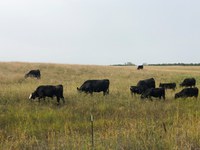Grassland quality can impact rebreeding success in beef cattle
(Click the image below to view a high-resolution image that can be downloaded)
Cattle producers often eagerly anticipate this time of year with pasture turnout and a new breeding season in the near future; however, this time of year also presents challenges as producers plan grazing and reproductive management strategies.
A successful breeding season starts long before bulls get turned out, and a large part of that success relies on providing proper nutrition to beef females. The expectations are high for a postpartum cow, says Lacey Quail, North Dakota State University Extension livestock management specialist at the North Central Research Extension Center.
A cow must first start cycling again after calving, then become pregnant within 80 to 85 days after calving to maintain a yearly calving interval, all while lactating to raise the calf she just birthed.
The first 90 days after calving are the most nutritionally demanding, says Quail. Because lactation takes priority over reproducing for next year, cows will devote nutrients to milk production first and require additional nutrients to successfully rebreed. This can be difficult considering peak milk production overlaps with when cows need to be recycling to prepare for the following breeding season. This places a huge nutrient demand on beef females. More specifically, a beef cow that calved two months ago (peak lactation) may require 1.5 times the protein and energy that she required in late gestion — just three months before calving. Therefore, it is not uncommon to see cows losing body condition during this time if their diet is not meeting their protein and energy requirements.
Cattle that lose body condition after calving and enter the breeding season in thin condition have lower conception rates. More specifically, research has reported that cattle entering the breeding season with three to five ribs and a slight spinal outline visible (body condition score 4) had a 58% pregnancy rate, even after an extended breeding season. In the same study, pregnancy success increased to 85% in cattle that entered the breeding in a moderate body condition (body condition score 5).
“Even if cattle calve in an adequate body condition,” says Quail, “neglecting to supply their increased nutrient requirements after calving can be extremely detrimental to herd productivity and profitability.”
As many cattle are being transitioned to pasture in late spring, managing pasture readiness and forage production in tandem with supplying the increased nutrient requirements of postpartum cows can be difficult. To aid in managing the nutrition of grazing animals, it is important to know the dominant grass species that your cows are grazing, as different species have different nutritional value. In North Dakota, grasslands are becoming cool-season dominant due to increased invasion of the cool-season-introduced grasses, Kentucky bluegrass and smooth brome.
“This increase in cool-season grasses and subsequent decrease in warm-season grasses is causing a seasonal shift in the nutrition of rangeland,” says Miranda Meehan, NDSU Extension livestock environmental stewardship specialist.
Typically, pasture turnout takes place in mid-May to early June, when grasses are growing actively. At this time, crude protein and total digestible nutrient (TDN) levels are high (greater than 15% and 60%, respectively) and easily meet cow requirements. As the summer progresses, the quality of cool-season grasses rapidly declines, which can be compensated by warm-season species that are actively growing during this period. By the end of the growing season in September and October, standing forage is low in crude protein, with cool-season species being about 5% protein and warm-season species being between 4% and 8%, depending on the species. Energy also will be low for these forages, with cool-season species falling below 50% TDN and warm-season species at about 52% TDN.
Meehan emphasizes that understanding the relationship between forage quality and the nutrient requirements of livestock is important. While forages typically meet requirements for lactating cows during late May and early June, cows that are calving before April will reach peak milk production before then. Enhanced knowledge of the grass species can improve pasture and herd health.
NDSU Agriculture Communication – May 8, 2025
Source: Lacey Quail, 701-831-0414, lacey.quail@ndsu.edu
Source: Miranda Meehan, 701-231-7683, miranda.meehan@ndsu.edu
Editor: Dominic Erickson, 701-231-5546, dominic.erickson@ndsu.edu


